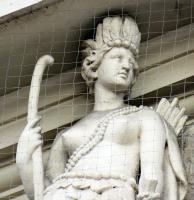
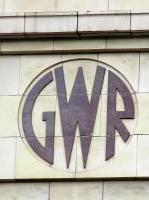
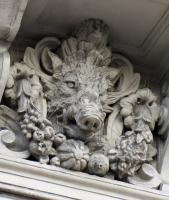
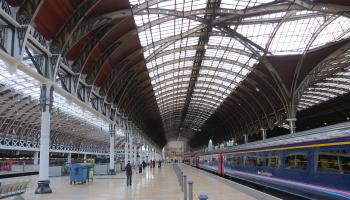

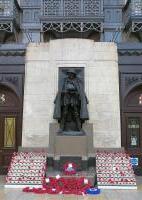
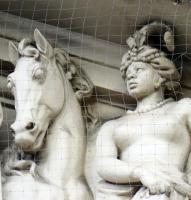
The Great Western Hotel by Paddington Station has a noble pediment with figure sculpture by the eminent Victorian sculptor John Thomas, and within Paddington Railway Station itself are three statues.
We start with the building and its pediment. Philip Hardwick the Younger (1822-1892) was the architect of the Great Western Hotel, which was completed in 1854, shortly after Paddington Station itself was built. It is large, facing onto Praed Street, which is not wide enough to get the distant view one would wish. The familiar view therefore is an oblique one of two square towers, not so much higher than the rest of the building, and crowned with slate roofs, flanked by chimneys and with a balustrade. All this, especially the mansard roofs, in French style, described when it was built as 'in the taste of the age of Louis XIV, or somewhat later'.
Paddington Station, Great Western Hotel.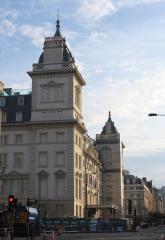
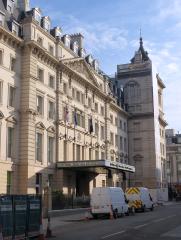
Between the towers is the rather flat frontage of the Hotel, essentially rows of windows in a Classical format, with a plain ground floor, the first floor being the principal one with the tallest windows, with little pediments, and then four successively less important lines of windows, the uppermost of which are above a balustrade and dormer windows respectively. The pediment is above the third floor balustrade, and instead of being supported on pillars, has simply the projecting elements of the façade.
Paddington Station Hotel: Pediment by John Thomas as it was and is.
Within the pediment is the figure sculpture we want to see: ten Classical figures standing and reclining, a camel, a horse and an elephant, and a couple of putti, along with various implements. The group represents Peace, Plenty, Industry and Science. John Thomas, a now little known but extremely good sculptor, shows his skill at composition in this work. There are 10 full sized figures in the pediment, of which two are seated on one side, one on the other, and three large animals, and yet a perfect balance between the two sides is maintained. The centremost group has the tall figure of Peace, hands outstretched in front of two very similar figures with reflected poses, an arm across the body, the head turned inwards, the forward leg outwards, giving a lithe twist to the body; one carries a flowering staff, the other a cornucopia (i.e. symbolising Plenty). Next on each side is a group of a small putto with pottery, and above and behind, a woman with an animal. To the left as we look at the pediment, she is an exotic figure in a turban, standing almost in profile and holding the rein of a camel, representing perhaps trade with the Orient; to the right, a figure of Europa has a horse – the figure and the positioning of the horse is reversed.
Central figure of Peace, and inner figures including America and Europe.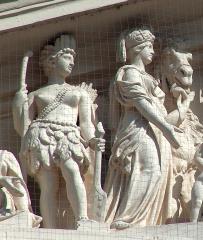
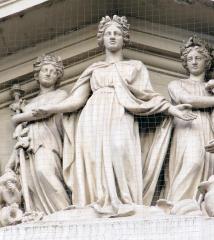
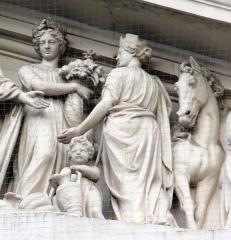
Next outward are two more groups, tucked in close so the eye does not particularly separate them, but completely distinct. To the left, a figure of America, a splendid barbarian girl, semi-nude and carrying a paddle and longbow, and wearing a nice skirt of feathers to match her feathered headdress; seated next to her on the ground is another girl, wearing a robe and gaudy jewellery, with a second camel glimpsed behind her. The balancing figures on the right are Africa, a solid figure, again semi-nude with headdress, ostrich feather perhaps, and long skirt; she rests her hand on the brow of a crouched-down elephant – not many sculptors would be able to balance a seated figure on one side with an elephant on the other (more elephant sculpture on this page).
All of these figures are on a low, central plinth rising gently at the centre. But our final two figures, one seated girl on each side, are lower down to fit under the descending cornices of the pediment. She to the left is resting an elbow on a globe, on her lap a parchment on which she measures with a pair of callipers, and out into the sharp corner of the pediment we see a heavy press, a large gearwheel and a geometric cone; lost from the group are the inscribed picture of intersecting curves and a projection device from the original design. She is surely an allegorical figure of Science Her sister to the far right holds a ship’s prow, I think, and has a sheaf of corn and a beehive and to her right what looks like a torpedo (though apparently the self propelled torpedo first emerged two years later, in 1866). Regardless, the rest of her accoutrements suggest she may be another embodiment Plenty, or else together these two reclining figures represent Science and Industry in the broadest sense. What an excellent group altogether, and what a shame we cannot see at a less oblique angle and from a bit higher up. (For more pediment sculpture, see this page).
Inside the Railway station now. The main statue is that on the Great Western Railway World War I Memorial – a standing figure of a soldier, over life size and given added breadth and bulk by his pose, feet spread well apart, and great coat open to the front and splaying to the sides. He wears helmet, long knotted scarf, and heavy trousers and boots, all adding to the sense of solidity, and looks downward at the open letter he holds in his hands, this downward glance giving a sombre, reflective mood to the statue. The sculptor was C. Sargeant Jagger, an important war artist, his best known work being the Royal Artillery Monument memorial at Hyde Park Corner. The figure here in Paddington Station exemplifies his style.
Great Western Railway World War I Memorial, by Sargeant Jagger.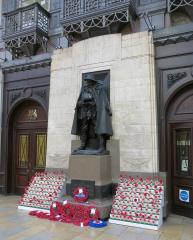
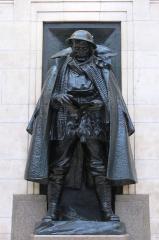
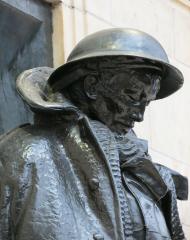
Brunel was the architect of the Railway Station itself, assisted by Matthew Digby Wyatt, brother of the more prolific architect Thomas Henry Wyatt and a member of the same gifted family which produced the sculptors Matthew Cotes Wyatt and Richard James Wyatt. The beautiful engine shed of Paddington Station was one of the first buildings after the Great Exhibition to use the same style of a repeating element of shaped steel. Look out for the almost art nouveau style leaf and insect-wing patterns, the raised balconies, and above the ticket office, complex leaf designs. The huge train sheds and the ironwork are best appreciated not from the front end, but looking back from the walkway at the far end (where the trains go out). There is always a faint haze (heat? pollution?) and this adds to the feeling of depth and size.
Brunel statue, 1982, by John Doubleday.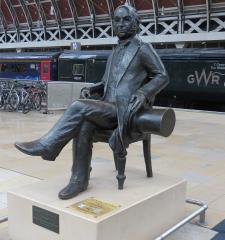
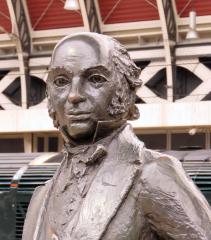
So we have as our second statue in Paddington Station a modern statue of Brunel, emplaced in 1982 (though not in its current position). The sculptor is John Doubleday, who made the statue of Sherlock Homes outside Baker Street station. As is typical with much modern figure sculpture, the emphasis is on the face and head, and the hands, which are good, with a sketchiness to the clothing; contrast the treatment of the coat with Victorian work. The statue is seated on a chair, just bulky enough to give some solidity and avoid a sense of floating. Seated figures are not so common, but are becoming more so, as one of a number of ways to make portrait sculpture more informal and closer to the viewer rather than orating on a high pedestal.
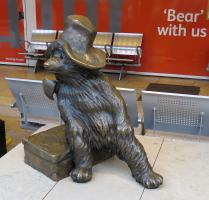 Paddington Bear, by Marcus Cornish.
Paddington Bear, by Marcus Cornish.
The third statue actually in Paddington Railway Station is a rather sentimental one of Paddington Bear, put there in 2000, made by the sculptor Marcus Cornish, who was also responsible for the stag in St James’s Square – see this page.
Just a few hundred yards to the north is Paddington Green, where the Church of St Mary Paddington Green contains many good things sculptural.
Another London railway station with sculpture: Victoria Station
London sculpture // Sculpture pages
Visits to this page from 10 Mar 2017: 7,692